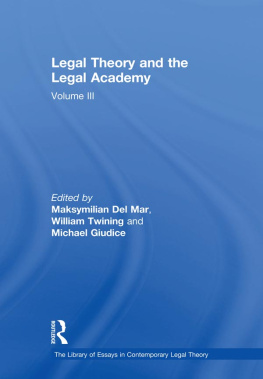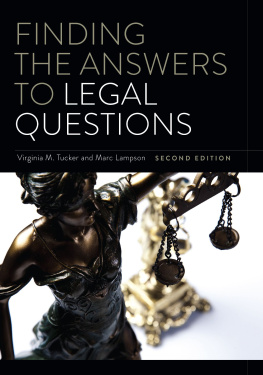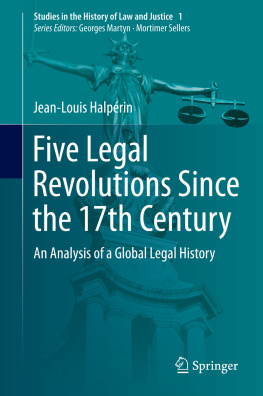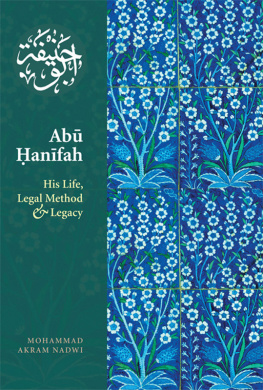Canadas
Legal Pasts
Canadas
Legal Pasts
Looking forward, looking back
Edited by
Lyndsay Campbell,
Ted McCoy, and
Mlanie mthot
2020 Lyndsay Campbell, Ted McCoy, and Mlanie Mthot
University of Calgary Press
2500 University Drive NW
Calgary, Alberta
Canada T2N 1N4
press.ucalgary.ca
This book is available as an ebook which is licensed under a Creative Commons license. The publisher should be contacted for any commercial use which falls outside the terms of that license.
Library and Archives Canada Cataloguing in Publication
Title: Canadas legal pasts : looking forward, looking back / edited by Lyndsay Campbell,
Ted McCoy, and Mlanie Mthot.
Names: Campbell, Lyndsay, editor. | McCoy, Ted, 1978- editor. | Mthot, Mlanie, 1970
editor.
Description: Includes bibliographical references and index. | Text in English; includes
one chapter in French.
Identifiers: Canadiana (print) 20200182692 | Canadiana (ebook) 20200182749 | ISBN
9781773851167 (softcover) | ISBN 9781773851518 (hardcover) | ISBN 9781773851174
(Open access PDF) | ISBN 9781773851181 (PDF) | ISBN 9781773851198 (EPUB) | ISBN
9781773851204 (Kindle)
Subjects: LCSH: LawCanadaHistory. | LCSH: LawHistoryResearch
Methodology. | LCSH: LawCanadaSources.
Classification: LCC KE394 .C36 2020 | LCC KF345 .C36 2020 kfmod | DDC 349.7109
dc23
The University of Calgary Press acknowledges the support of the Government of Alberta through the Alberta Media Fund for our publications. We acknowledge the financial support of the Government of Canada. We acknowledge the financial support of the Canada Council for the Arts for our publishing program.

Copyediting by Francine Michaud
Cover image: Group of Bloods at Fort Calgary, Alberta, 1878, NA-354-23. Image courtesy of the Glenbow Archives, Archives and Special Collections, University of Calgary.
Cover design, page design, and typesetting by Melina Cusano
For Louis A. Knafla, who inspires us all.
Contents
Nick Austin
Ted McCoy, Lyndsay Campbell, and Mlanie Mthot
Eric H. Reiter
Ted McCoy
Mlanie Mthot
Lyndsay Campbell
Christopher Shorey
Angela Fernandez
Catharine MacMillan
Alexandra Havrylyshyn
Jean-Philippe Garneau
Shelley A.M. Gavigan
Dominique Clment
Louis A. Knafla
foreword
A Students Take on Canadas Legal Pasts
Nick Austin
In July 2017, I immersed myself in the Canadas Legal Past conference at the University of Calgary. This was my first introduction to Canadian legal history, a field that I came to see as central to my own interests, learning, and understanding as a law student. The pieces in this collection are a marker of what students in multiple fields can learn through attention to the legal histories of Canadas past.
Both at the conference and in reading the volume, I have been most taken with what one might call the mythology building. As a young nation, we are still searching for the moments and individuals that define our collective Canadian mythos. Where will Canadian legal historians find their totemic figurestheir heroes and villains? Should we reject the totemic figures of previous generationsthe John Beverley Robinsons and William Osgoodesin favour of unknown figures? Could these be the mounted police recruits brought to life by Shelley Gavigan? The enterprising legal professionals examined by Alexandra Havrylyshyn, who challenges the myth that there were no lawyers in New France? Or perhaps, like me, one may be struck by the detail and charm of The Last Voyage of the Frederick Gerring, Jr ., by Christopher Shorey, an exploration of a possible Canadian Pierson v. Post analogue with enough narrative finesse to tap into the latent maritime nostalgia that I did not suspect I had. If I were unafraid of writing in hackneyed grade-school clichs, I might say that it makes history come alive. Or, perhaps Albertans like myself will find it enlightening to peek behind our cultivated sense of identity and unravel the mythology with Louis A. Knaflas examination of the writing of prairie history. Speaking of ingrained social praxis, Dominique Clment and Jean-Philippe Garneaus explorations of gender may help readers better understand the unique place of women in our legal past and present: Clment examines the incremental and imperfect development of sex discrimination law in Canada, while Garneau analyses 250 civil cases of married women asking for a sparation de biens in Montreal judicial district between 17951827.
I am also struck by the great variety of methodological approaches (the how as opposed to the what). Eric Reiter looks to Quebecs civil court archives (gleaning unpublished details, litigation strategies, and allegations from case files) in his writing on early defamation cases. Catharine MacMillan describes untapped archival resources about the Judicial Committee of the Privy Council in London, England, resources that may help enhance our understanding of how this body influenced the development of Canadian law beyond the constitutional sphere. Lyndsay Campbell discusses her use of newspaper accounts and pamphlets in her work on mid-nineteenth century libel cases and the controversies they reveal. Ted McCoy addresses historiographical concerns when approaching the vast Kingston Penitentiary archives, and by extension the lives of the workers and the women prisoners who resided there. Angela Fernandez examines the role of legal publishing in determining which text a judge had at hand. Regardless of the specific approaches taken by the authors, embedded in these pieces are countless moments of hard-fought discovery, understanding and, undoubtedly, gratification. Mlanie Mthot, for example, acknowledges the visceral thrill of leafing through time-worn paper ephemera in her work on bigamy cases. Most importantly, this collection is both inspired and inspiring, and I am excited to consider where the field may go next.
introduction
Canadas Legal Pasts: Looking Forward, Looking Back
Ted McCoy, Lyndsay Campbell, and Mlanie Mthot
In 1977 a group of historians met at Laval University to consider the emergence of Canadian legal history as a distinct and worthy field of study. Although legal history in Britain and the United States enjoyed a longer and more established tradition, in Canada it was in its formative stages in the 1970s. It emerged alongside a growing interest in fields of Canadian studies, gender studies, and social historyall fields that the study of law would eventually touch upon and incorporate into its own development. Over forty years have passed since that first conference, eventful decades in which the field has matured and absorbed theoretical and methodological developments in scholarship, while profiting from the tremendous improvement in the availability of sources that has come with digitization projects now widely accessible on the internet. In this introduction to Canadas Legal Pasts: Looking Forward, Looking Back , we outline some key moments. By foregrounding Canadian legal historys rich array of sources, methodologies, and questions, this book not only marks the maturity of the field but also aims to welcome new scholars and new contributions.










